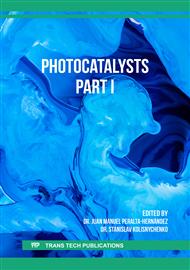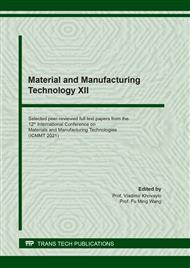[1]
Q. Z. Wu, X. Chen, P. Zhang, Y. C. Han, X. M. Chen, Y. H. Yan and S. P. Li, Amino acid-assisted synthesis of ZnO hierarchical architectures and their novel photocatalytic activities. Crystal Growth & Design, 8 (2008) 3010-3018.
DOI: 10.1021/cg800126r
Google Scholar
[2]
S. C. Karumuthil, K. Singh, U. Valiyaneerilakkal, J. Akhtar, S. Varghese, Fabrication of poly (vinylidene fluoride-trifluoroethylene) – Zinc oxide based piezoelectric pressure sensor[J]. Sensors and Actuators A: Physical, 303 (2020) 111677.
DOI: 10.1016/j.sna.2019.111677
Google Scholar
[3]
F. Cao, C. Li, M. Li, Direct growth of Al-doped ZnO ultrathin nanosheets on electrode for ethanol gas sensor application. Applied Surface Science, 447 (2018) 173-181.
DOI: 10.1016/j.apsusc.2018.03.217
Google Scholar
[4]
J. Im, F.E. Lofflfler, Fate of bisphenol A in terrestrial and aquatic environments, Environ. Sci. Technol. 50 (2016) 8403-8416.
DOI: 10.1021/acs.est.6b00877
Google Scholar
[5]
C. Lei, M. Pi, C. Jiang, B. Cheng, J. Yu, Synthesis of hierarchical porous zinc oxide (ZnO) microspheres with highly effificient adsorption of Congo red, J. Colloid Interface Sci. 490 (2017) 242-251.
DOI: 10.1016/j.jcis.2016.11.049
Google Scholar
[6]
C. Qi, X. Liu, J. Ma, C. Lin, X. Li, H. Zhang, Activation of peroxymonosulfate by base: implications for the degradation of organic pollutants, Chemosphere 151 (2016) 280-288.
DOI: 10.1016/j.chemosphere.2016.02.089
Google Scholar
[7]
C. Sushma, S.G. Kumar, Advancements in the zinc oxide nanomaterials for effificient photocatalysis, Chem. Pap. 71 (2017) 2023-2042.
DOI: 10.1007/s11696-017-0217-5
Google Scholar
[8]
Y. Jin, J. Wang, B. Sun, J. C. Blakesley and N. C. Greenham, Nano Lett., 8 (2008) 1649–1653.
Google Scholar
[9]
K. Qi, B. Cheng, J. Yu, W. Ho, Review on the improvement of the photocatalytic and antibacterial activities of ZnO, J. Alloy. Comp. 727 (2017) 792-820.
DOI: 10.1016/j.jallcom.2017.08.142
Google Scholar
[10]
Z. W. Pan, Nanobelts of semiconducting oxides. Science, 291 (2001) 1947-1949.
Google Scholar
[11]
J. Y. Lao, J. Y. Huang, D. Z. Wang, ZnO nanobridges and nanonails. Nano Letters, 3 (2003) 235-238.
DOI: 10.1021/nl025884u
Google Scholar
[12]
J. Lao, J. Wen, J. Huang, Hierarchical ZnO nanostructures. Nano Letters, 2 (2002) 1287-1291.
Google Scholar
[13]
M. H. Huang, Room-temperature ultraviolet nanowire nanolasers. Science, 292 (2001) 1897-1899.
Google Scholar
[14]
S. Wang, P. Kuang, B. Cheng, ZnO hierarchical microsphere for enhanced photocatalytic activity. Journal of Alloys & Compounds, 741 (2018) 622-632.
DOI: 10.1016/j.jallcom.2018.01.141
Google Scholar
[15]
M. Nafees, W. Liaqut, S. Ali S, Synthesis of ZnO/Al:ZnO nanomaterial: structural and band gap variation in ZnO nanomaterial by Al doping. Applied Nanoscience, 3 (2013) 49-55.
DOI: 10.1007/s13204-012-0067-y
Google Scholar
[16]
H. Zhang, D. Yang, X. Ma, et al. Synthesis of flower-like ZnO nanostructures by an organic-free hydrothermal process. Nanotechnology, 15 (2004) 622-626.
DOI: 10.1088/0957-4484/15/5/037
Google Scholar
[17]
S. Rani, P. Suri, P. K. Shishodia, et al. Synthesis of nanocrystalline ZnO powder via sol–gel route for dye-sensitized solar cells. Solar Energy Materials and Solar Cells, 2008, 92 (12):1639-1645.
DOI: 10.1016/j.solmat.2008.07.015
Google Scholar
[18]
Y. Liu, D. Wang, Q. Peng, et al. Directly assembling ligand-free ZnO nanocrystals into three-dimensional mesoporous structures by oriented attachment. Inorganic Chemistry, 50 (2011) 5841-5847.
DOI: 10.1021/ic2009013
Google Scholar
[19]
C. D. Wagner, L. H. Gale, R. H. Raymond, Two-dimensional chemical state plots: a standardized data set for use in identifying chemical states by x-ray photoelectron spectroscopy. Analytical Chemistry, 51 (1979) 466-482.
DOI: 10.1021/ac50040a005
Google Scholar
[20]
J. C. C. Fan, J. B. Goodenough, X-ray Photoemission Spectroscopy Studies of Sn-Doped Indium Oxide Films. Journal of Applied Physics, 48 (1977) 3524-3531.
DOI: 10.1063/1.324149
Google Scholar
[21]
I. G. Morozov, O. V. Belousova, D. Ortega, et al. Structural, optical, XPS and magnetic properties of Zn particles capped by ZnO nanoparticles. Journal of Alloys and Compounds, 633 (2015) 237-245.
DOI: 10.1016/j.jallcom.2015.01.285
Google Scholar
[22]
H. Zhang, X. Lv, Y. Li, et al. P25-graphene composite as a high performance photocatalyst. Acs Nano, 4 (2010) 380-386.
DOI: 10.1021/nn901221k
Google Scholar
[23]
S. Zhang, H. S. Chen, K. M. Postolek and Ping. Yang. ZnO nanoflowers with single crystal structure towards enhanced gas sensing and photocatalysis. Phys. Chem. Chem. Phys., 17 (2015) 30300-30306.
DOI: 10.1039/c5cp04860e
Google Scholar



